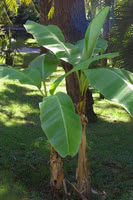Mon-Fri 9am - 5pm Mountain time
Western Snowberry vs Hardy Banana
Symphoricarpos occidentalis
Musa basjoo
NOT AVAILABLE THIS SEASON - MIGHT RETURN
CUSTOM GROW
Like the Common Snowberry, the Western Snowberry is a small shrub with pink flowers useful for feeding livestock and preventing erosion. Unlike the common species, however, the Western Snowberry is much more suited to wet conditions, capable of persevering through poor soil drainage and occasional flooding.
After the Snowberry's flowers have bloomed, it produces berries which often last on the plant through winter. These berries are toxic to humans, but livestock and local wildlife love them! Those hoping to attract wildlife to their property can plant Snowberry and expect to see animals foraging on it much later in the year than other plants.
The Hardy Banana is a fast-growing evergreen perennial that dies down to the ground each year. A stunning tropical-looking accent for your yard and patio, the Japanese Fiber Banana can be overwintered outdoors in several northern U.S. states and southern Canadian regions. In northern regions, you can bring this plant inside and leave it in your garage. If you enjoy Mexican cuisine, you can use the leaves to make tamales.
Western Snowberry Quick Facts
Hardy Banana Quick Facts
Toxicity: berries are toxic to humans

